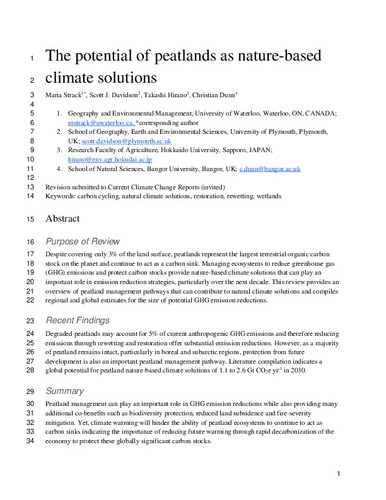| dc.contributor.author | Strack, Maria | |
| dc.contributor.author | Davidson, Scott J | |
| dc.contributor.author | Hirano, Takashi | |
| dc.contributor.author | Dunn, Christian | |
| dc.date.accessioned | 2023-05-03 16:42:00 (GMT) | |
| dc.date.available | 2023-05-03 16:42:00 (GMT) | |
| dc.date.issued | 2022-09 | |
| dc.identifier.uri | https://doi.org/10.1007/s40641-022-00183-9 | |
| dc.identifier.uri | http://hdl.handle.net/10012/19410 | |
| dc.description | This is a post-peer-review, pre-copyedit version of an article published in Carbon Cycle and Climate. The final authenticated version is available online at: https://doi.org/10.1007/s40641-022-00183-9 | en |
| dc.description.abstract | Purpose of Review
Despite covering only 3% of the land surface, peatlands represent the largest terrestrial organic carbon stock on the planet and continue to act as a carbon sink. Managing ecosystems to reduce greenhouse gas (GHG) emissions and protect carbon stocks provide nature-based climate solutions that can play an important role in emission reduction strategies, particularly over the next decade. This review provides an overview of peatland management pathways that can contribute to natural climate solutions and compiles regional and global estimates for the size of potential GHG emission reductions.
Recent Findings
Degraded peatlands may account for 5% of current anthropogenic GHG emissions and therefore reducing emissions through rewetting and restoration offer substantial emission reductions. However, as a majority of peatland remains intact, particularly in boreal and subarctic regions, protection from future development is also an important peatland management pathway. Literature compilation indicates a global potential for peatland nature-based climate solutions of 1.1 to 2.6 Gt CO2e yr-1 in 2030.
Summary
Peatland management can play an important role in GHG emission reductions while also providing many additional co-benefits such as biodiversity protection, reduced land subsidence and fire-severity mitigation. Yet, climate warming will hinder the ability of peatland ecosystems to continue to act as carbon sinks indicating the importance of reducing future warming through rapid decarbonization of the economy to protect these globally significant carbon stocks. | en |
| dc.language.iso | en | en |
| dc.publisher | Springer | en |
| dc.relation.ispartofseries | Carbon Cycle and Climate; | |
| dc.rights | Attribution 4.0 International | * |
| dc.rights.uri | http://creativecommons.org/licenses/by/4.0/ | * |
| dc.subject | carbon cycling | en |
| dc.subject | natural climate solutions | en |
| dc.subject | restoration | en |
| dc.subject | rewetting | en |
| dc.subject | wetlands | en |
| dc.title | The potential of peatlands as nature-based climate solutions | en |
| dc.type | Article | en |
| dcterms.bibliographicCitation | Strack, M., Davidson, S. J., Hirano, T., Dunn, C. 2022. The potential of peatlands as nature-based climate solutions, Current Climate Change Reports, 8, 71-82, https://doi.org/10.1007/s40641-022-00183-9 | en |
| uws.contributor.affiliation1 | Faculty of Environment | en |
| uws.contributor.affiliation2 | Geography and Environmental Management | en |
| uws.typeOfResource | Text | en |
| uws.peerReviewStatus | Reviewed | en |
| uws.scholarLevel | Faculty | en |


